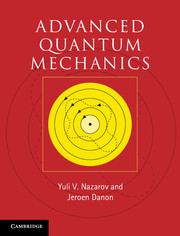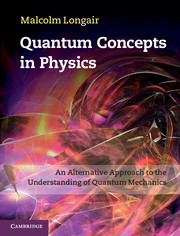Refine search
Actions for selected content:
3361 results in Quantum Physics, Quantum Information and Quantum Computation
Frontmatter
-
- Book:
- Quantum Computing since Democritus
- Published online:
- 05 April 2013
- Print publication:
- 14 March 2013, pp i-iv
-
- Chapter
- Export citation

Advanced Quantum Mechanics
- A Practical Guide
-
- Published online:
- 05 February 2013
- Print publication:
- 03 January 2013

Quantum Concepts in Physics
- An Alternative Approach to the Understanding of Quantum Mechanics
-
- Published online:
- 05 February 2013
- Print publication:
- 31 January 2013
Part III - The Discovery of Quantum Mechanics
-
- Book:
- Quantum Concepts in Physics
- Published online:
- 05 February 2013
- Print publication:
- 31 January 2013, pp 187-188
-
- Chapter
- Export citation
Frontmatter
-
- Book:
- Quantum Concepts in Physics
- Published online:
- 05 February 2013
- Print publication:
- 31 January 2013, pp i-vi
-
- Chapter
- Export citation
10 - The collapse of the old quantum theory and the seeds of its regeneration
- from Part III - The Discovery of Quantum Mechanics
-
- Book:
- Quantum Concepts in Physics
- Published online:
- 05 February 2013
- Print publication:
- 31 January 2013, pp 189-202
-
- Chapter
- Export citation
15 - Reconcilingmatrix and wave mechanics
- from Part III - The Discovery of Quantum Mechanics
-
- Book:
- Quantum Concepts in Physics
- Published online:
- 05 February 2013
- Print publication:
- 31 January 2013, pp 292-311
-
- Chapter
- Export citation
Part I - The Discovery of Quanta
-
- Book:
- Quantum Concepts in Physics
- Published online:
- 05 February 2013
- Print publication:
- 31 January 2013, pp 1-2
-
- Chapter
- Export citation
Name index
-
- Book:
- Quantum Concepts in Physics
- Published online:
- 05 February 2013
- Print publication:
- 31 January 2013, pp 432-435
-
- Chapter
- Export citation
Preface
-
- Book:
- Quantum Concepts in Physics
- Published online:
- 05 February 2013
- Print publication:
- 31 January 2013, pp xii-xv
-
- Chapter
- Export citation
Notes
-
- Book:
- Quantum Concepts in Physics
- Published online:
- 05 February 2013
- Print publication:
- 31 January 2013, pp 389-404
-
- Chapter
- Export citation
11 - The Heisenberg breakthrough
- from Part III - The Discovery of Quantum Mechanics
-
- Book:
- Quantum Concepts in Physics
- Published online:
- 05 February 2013
- Print publication:
- 31 January 2013, pp 203-223
-
- Chapter
- Export citation
1 - Physics and theoretical physics in 1895
- from Part I - The Discovery of Quanta
-
- Book:
- Quantum Concepts in Physics
- Published online:
- 05 February 2013
- Print publication:
- 31 January 2013, pp 3-23
-
- Chapter
- Export citation
5 - Sommerfeld and Ehrenfest – generalising the Bohr model
- from Part II - The Old Quantum Theory
-
- Book:
- Quantum Concepts in Physics
- Published online:
- 05 February 2013
- Print publication:
- 31 January 2013, pp 90-118
-
- Chapter
- Export citation
13 - Dirac's quantum mechanics
- from Part III - The Discovery of Quantum Mechanics
-
- Book:
- Quantum Concepts in Physics
- Published online:
- 05 February 2013
- Print publication:
- 31 January 2013, pp 247-260
-
- Chapter
- Export citation
Epilogue
-
- Book:
- Quantum Concepts in Physics
- Published online:
- 05 February 2013
- Print publication:
- 31 January 2013, pp 388-388
-
- Chapter
- Export citation
16 - Spin and quantum statistics
- from Part III - The Discovery of Quantum Mechanics
-
- Book:
- Quantum Concepts in Physics
- Published online:
- 05 February 2013
- Print publication:
- 31 January 2013, pp 312-342
-
- Chapter
- Export citation
9 - The wave–particle duality
- from Part II - The Old Quantum Theory
-
- Book:
- Quantum Concepts in Physics
- Published online:
- 05 February 2013
- Print publication:
- 31 January 2013, pp 172-186
-
- Chapter
- Export citation
Acknowledgements
-
- Book:
- Quantum Concepts in Physics
- Published online:
- 05 February 2013
- Print publication:
- 31 January 2013, pp xvi-xviii
-
- Chapter
- Export citation
Contents
-
- Book:
- Quantum Concepts in Physics
- Published online:
- 05 February 2013
- Print publication:
- 31 January 2013, pp vii-xi
-
- Chapter
- Export citation
